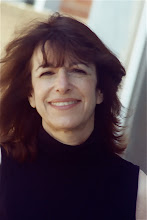
Many years ago, I checked Jonah Winter's Diego out of the library for my young children. The book begins
"Deep i
 n the mountains of Mexico there was a town called Guanajuato. And in Guanajuato there were two happy parents. They were happy because they had twin sons, Diego and Carlos."
n the mountains of Mexico there was a town called Guanajuato. And in Guanajuato there were two happy parents. They were happy because they had twin sons, Diego and Carlos."Diego falls ill and is taken to an Indian healer, who has "magical things" in her small hut. What a delight it was to discover, a few pages later, that this simple text reminiscent of folktales was in fact a biography of Diego Rivera.
Diego was published in 1991 (and it inspired me to write my first p.b. bio, Dreamer from the Village: The Story of Marc Chagall). Since then, more and more authors have been bending the genre.
Consider the range of approaches and tones in the openings of following picture book biographies:
"You gotta be kid
 ding! You never heard of Sandy Koufax? He was only the greatest lefty who ever pitched in the game of baseball. Well, for six years he was, anyway. From 1961 to 1966, almost no one could hit the guy. The mighty Mickey Mantle, one of the greatest power hitters of all time:whiff! After the Mick struck out one day, he turned to the catcher and said, "what the heck was THAT?"
ding! You never heard of Sandy Koufax? He was only the greatest lefty who ever pitched in the game of baseball. Well, for six years he was, anyway. From 1961 to 1966, almost no one could hit the guy. The mighty Mickey Mantle, one of the greatest power hitters of all time:whiff! After the Mick struck out one day, he turned to the catcher and said, "what the heck was THAT?"-You Never Heard of Sandy Koufax?! by Jonah Winter and Andre Carrilho
The narrator of the book is an anonymous veteran teammate. Note his lively, period language, and how he involves the reader/listener (as did Laurie Halse Andersen, earlier, in Thank You, Sarah.)
Carole Boston Weatherford's biography of Jesse Owens, written in the second person, puts the reader in the position of addressing (and rooting for) the athlete:
"Go from cotton fiel
 ds to city sidewalks/from sickly child to keen competitor/ from second class citizen to first place finisher/Go, Jesse, go. Trounce Jim Crow/ Run as fast as your feet can fly/ As far as your dreams will reach." - Jesse Owens: Fastest Man Alive
ds to city sidewalks/from sickly child to keen competitor/ from second class citizen to first place finisher/Go, Jesse, go. Trounce Jim Crow/ Run as fast as your feet can fly/ As far as your dreams will reach." - Jesse Owens: Fastest Man AliveAn unusual and impassioned way of telling the dramatic story of the African American who captured four medals at Hitler's 1936 Berlin Olympics.
M.T. Anderson begins his story of Erik Satie with poetry and mystery:

"Erik Satie/was born by the sea/ in the village of Honfleur/on the coast of France./ It was 1866. "I was born/very young/ in a very old world," said Satie once. / And he never grew up/but was always a child/ with an old man's smile."
Anderson's rhythmic language, full of quirky imagery, captures the essence of this eccentric musician.
Expressive language can lend poignancy to bios written in the traditional format. This lyrical passage introduces us to a devoted, little known nature painter:

"There was once a man whose love of nature was as wide as the world. There was once an artist who needed to paint as much as he needed to breathe. There was once an islander who lived in a cottage at the edge of Mississippi, where the sea meets the earth and the sky. His name is Walter Anderson. He may be the most famous American artist you've never heard of."-The Secret World of Walter Anderson by Hester Bass.
Authors of picture book biographies have more choices than ever. They can experiment with innovative storytelling techniques-invented narrators, interactivity, or unconventional formats. They can entertain young readers with humor, or touch their hearts with poetry.
As I begin writing my upcoming bio, I'll ask myself what tone, what approach, what "voice" best conveys the story I want to tell. How can I snare the young reader?
I also need to decide when to begin and end my story. But more on that next time. For more posts on the subject, check the labels to the right.








No comments:
Post a Comment